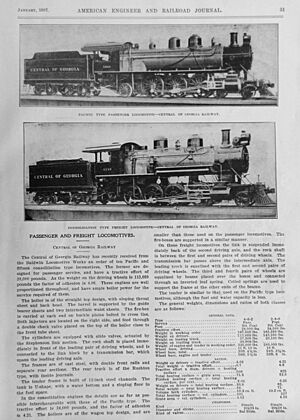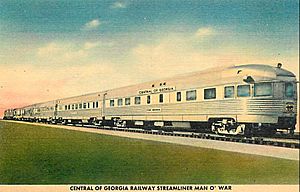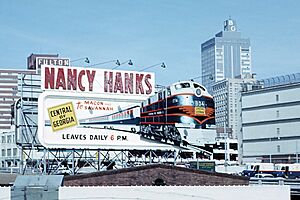Central of Georgia Railway facts for kids
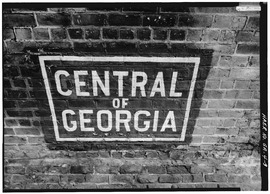 |
|
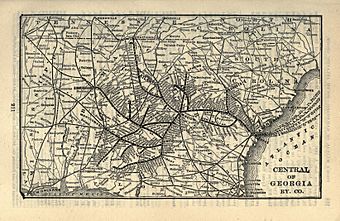
1903 map of the Central of Georgia Railway
|
|
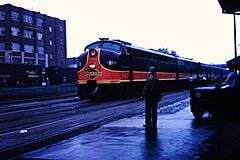
The City of Miami in 1964, painted in Illinois Central colors, not CofG's own livery
|
|
| Overview | |
|---|---|
| Headquarters | Savannah, Georgia |
| Reporting mark | CG |
| Locale | Georgia, Alabama |
| Dates of operation | 1895–1963 |
| Successor | split between Southern Railway later Norfolk Southern and St. Louis-San Francisco Railway then Burlington Northern now BNSF |
| Technical | |
| Track gauge | 4 ft 8 1⁄2 in (1,435 mm) standard gauge |
| Previous gauge | 5 ft (1,524 mm), civil war era and4 ft 9 in (1,448 mm) |
| Length | 1,944 miles (3,129 km) in 1929 |
The Central of Georgia Railway (also known as CofG) was a very important railroad in the southeastern United States. It began way back in 1833 as the Central Rail Road and Canal Company. Its main goal was to connect the city of Macon, Georgia with the port city of Savannah, Georgia. This connection helped link the Tennessee River all the way to the Atlantic Ocean.
Building the railroad took several years, from 1837 to 1843. During the American Civil War, parts of the railroad were destroyed by federal troops. Later, in 1963, the Southern Railway bought the company. It then became part of the Norfolk Southern Railway in 1982. It's good to know that the Georgia Central Railway is a different company and not related to the Central of Georgia Railway.
Contents
How the Railroad Grew Over Time
Over many years, the Central of Georgia Railway grew much larger. It did this by buying or leasing other smaller railroad companies. This helped the CofG expand its network and reach more cities and towns.
Key Moments in the Company's History
In 1888, a company called Richmond Terminal Company took control of the Central of Georgia. However, this parent company ran into money problems. Because of this, the CofG had to go through a process called bankruptcy. It was then reorganized and renamed the Central of Georgia Railway in 1895.
Later, in 1907, a famous railroad boss named E. H. Harriman became the main owner. He then sold his share to the Illinois Central Railroad in 1909. During the Great Depression in 1932, the CofG faced more financial trouble. It took until 1948 for the company to recover.
In 1956, the St. Louis-San Francisco Railway tried to take over the CofG. They wanted a route to the Atlantic Ocean. But the government agency in charge, the Interstate Commerce Commission, did not approve the merger. So, the Frisco company sold its shares to the Southern Railway in 1963.
By 1956, the Central of Georgia Railway operated over 1,764 miles of track. On June 17, 1963, it officially became a part of the Southern Railway. In 1971, the Southern Railway created a new company, the Central of Georgia Railroad. This new company combined the Central of Georgia Railway with a couple of other smaller railroads.
Trains for Passengers
The Central of Georgia Railway ran several famous passenger trains. One of the most well-known was the Nancy Hanks II. This train ran from Atlanta to Savannah, passing through Macon. It operated from 1947 to 1971. The "II" was added to its name to avoid confusion with an earlier train from the 1890s.
Another popular train was the Man o' War, which ran from Columbus to Atlanta. Both of these trains were named after famous racehorses. When Amtrak took over most passenger train services in 1971, the "Nancy Hanks II" was stopped.
Until the mid-1950s, the CofG also ran trains to the popular beach city of Panama City, Florida. Other long-distance trains from different companies also used Central of Georgia tracks. These included the City of Miami (from Chicago to Miami) and the Seminole (from Chicago to Jacksonville).
For a long time, CofG trains kept separate sections for different races. This was even after many other Southern railroads stopped this practice. The CofG mainly operated within Georgia and parts of Alabama, so it wasn't always under the same rules as trains that crossed many states.
The Central of Georgia Today
Today, the Central of Georgia Railway doesn't operate as a separate company. It exists as a "paper railroad" within the larger Norfolk Southern Railway group. This means its name is still used for some legal or historical reasons.
A part of the CofG's old main line, about 42 miles long, is currently leased by another railroad company called the Chattooga and Chickamauga Railway.
In 2012, to celebrate its 30th anniversary, Norfolk Southern painted 20 of its new locomotives in the colors of its older, historic railroad companies. One of these, NS 8101, was painted in the classic Central of Georgia colors. It's a way to remember the important history of this railroad.
Historic Places You Can Visit
Many old buildings and sites that belonged to the Central of Georgia Railway are now preserved as historic places. Some of these are listed on the National Register of Historic Places.
- The Central of Georgia Depot in Andalusia, Alabama, is one such preserved building.
- In Savannah, Georgia, the Georgia State Railroad Museum is located at the former Savannah Shops and Terminal Facilities. This site also includes the Savannah History Museum.
- The Macon Terminal Complex in Macon, Georgia is partly preserved. You can still see the main terminal building and parts of the old roundhouse where trains were turned around.
- The Central of Georgia Depot in Millen, GA, is still used today as offices for Norfolk Southern, the company that now owns the Central of Georgia's legacy.
Preserved Trains and Cars
Some of the actual locomotives (train engines) and rolling stock (passenger cars, freight cars) from the Central of Georgia Railway have been saved and are on display or used today.
Locomotives (Engines)
- Central of Georgia Railway 509 (a 2-8-0 type) is at Central City Park in Macon, Georgia.
- Central of Georgia Railway 349 (a 4-4-0 type) is on loan to the Children's Hospital at Erlanger in Chattanooga, Tennessee.
- Central of Georgia Railway 1 (an SW-1 type) is at the Georgia State Railroad Museum in Savannah, Georgia.
- Central of Georgia Railway 223 (a 2-8-0 type) is also at the Georgia State Railroad Museum.
Rolling Stock (Cars)
- Two "Jim Crow" Passenger Cars, 606 and 607, built in 1911, are now owned by the Tennessee Valley Railroad Museum.
- Passenger Car 660, built for the Nancy Hanks II in 1947, is on display in Meridian, Mississippi.
- Passenger Car 661, also built for the Nancy Hanks II, is owned by the Tennessee Valley Railroad Museum.
- Caboose 31580, built in 1937, is at the New Hope Railroad in New Hope, Pennsylvania.
- Caboose X-92, originally a boxcar from 1916, was converted into a caboose in 1942. It is now on display at the Southeastern Railway Museum in Duluth, Georgia.
Heritage Locomotive
As mentioned earlier, for Norfolk Southern's 30th anniversary, they painted 20 new locomotives to honor the railroads that came before them. One of these, NS #8101, is a modern GE ES44AC locomotive painted in the classic Central of Georgia colors. It's a moving tribute to the railway's long history.


